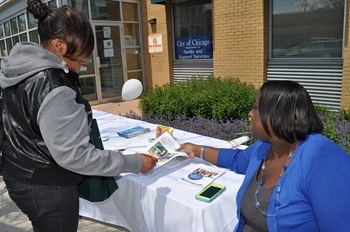UChicago’s CommunityRx Intervention
reprinted from Carl West/TBTNewsService.com
Published: February 16, 2017

New research from the University of Chicago Medicine shows a program that uses electronic medical records to connect Chicagoans with health resources in their community could be a model for other efforts nationally. That’s according to new findings published Nov. 9 in the Journal Health Affairs.
The program called CommunityRx launched in 2012 with funding from a $5.9 million federal innovation award. The program works by generating customized “e-prescriptions” called a HealtheRx for patients who visit nearly three dozen health clinics, including UChicago Medicine’s adult and pediatric emergency departments. Since it started, CommunityRx has generated more than 506,000 customized HealtheRx prescriptions for an estimated 200,000 or more patients.
The Health Affairs study assessed the program’s effectiveness by surveying 458 CommunityRx participants who received a HealtheRx prescription between 2012 and 2014. More than 83 percent reported the personalized referrals were “very useful.” Nearly one in five visited a place they learned about through the program. And all but one of six partnering health care organizations (involving 30 of 33 clinical sites) participating in the project continued using CommunityRx after the study period ended.
“To me, the most profound finding and one that motivated me to find a sustainable business model, was that more than half the participants surveyed used their HealtheRx to help connect someone else to community resources,” said Stacy Tessler Lindau, MD, an associate professor of obstetrics and gynecology at the University of Chicago. “I’m fascinated by the idea that we might motivate people to take better care of themselves by offering them a tool that make it easy to help others.”
kimeshaLindau directed CommunityRx, was the study’s lead author, and has founded a private social enterprise company that is commercializing the effort. CommunityRx connects patients with specific nearby places and community resources matched to their health needs. A person with diabetes might leave a checkup with an automatically created HealtheRx printout listing nearby locations for nutrition classes while someone with high blood pressure might get a prescription listing free area blood pressure screenings.
The backbone of the project, which was required by its grant funding to also have a sustainable business plan, is a continuously updated database of community assets that is merged with a patient’s electronic health record. The database inventory includes nearly 20,000 public-serving entities – from food banks to counseling centers – operating within a 107-square-mile area of Chicago’s South Side. The exhaustive catalog is created and updated by a team of high school students who walk every block of the area each summer to document the region’s businesses and organizations using a smartphone app.
Additional authors of the study, “CommunityRx: A population health improvement innovation that connects clinics to communities,” include Jennifer Makelarski, Emily Abramsohn, David G. Beiser, Veronica Escamilla, Jessica Jerome, Daniel Johnson, Abel N. Kho, Karen K. Lee, Timothy Long, and Doriane C. Miller.